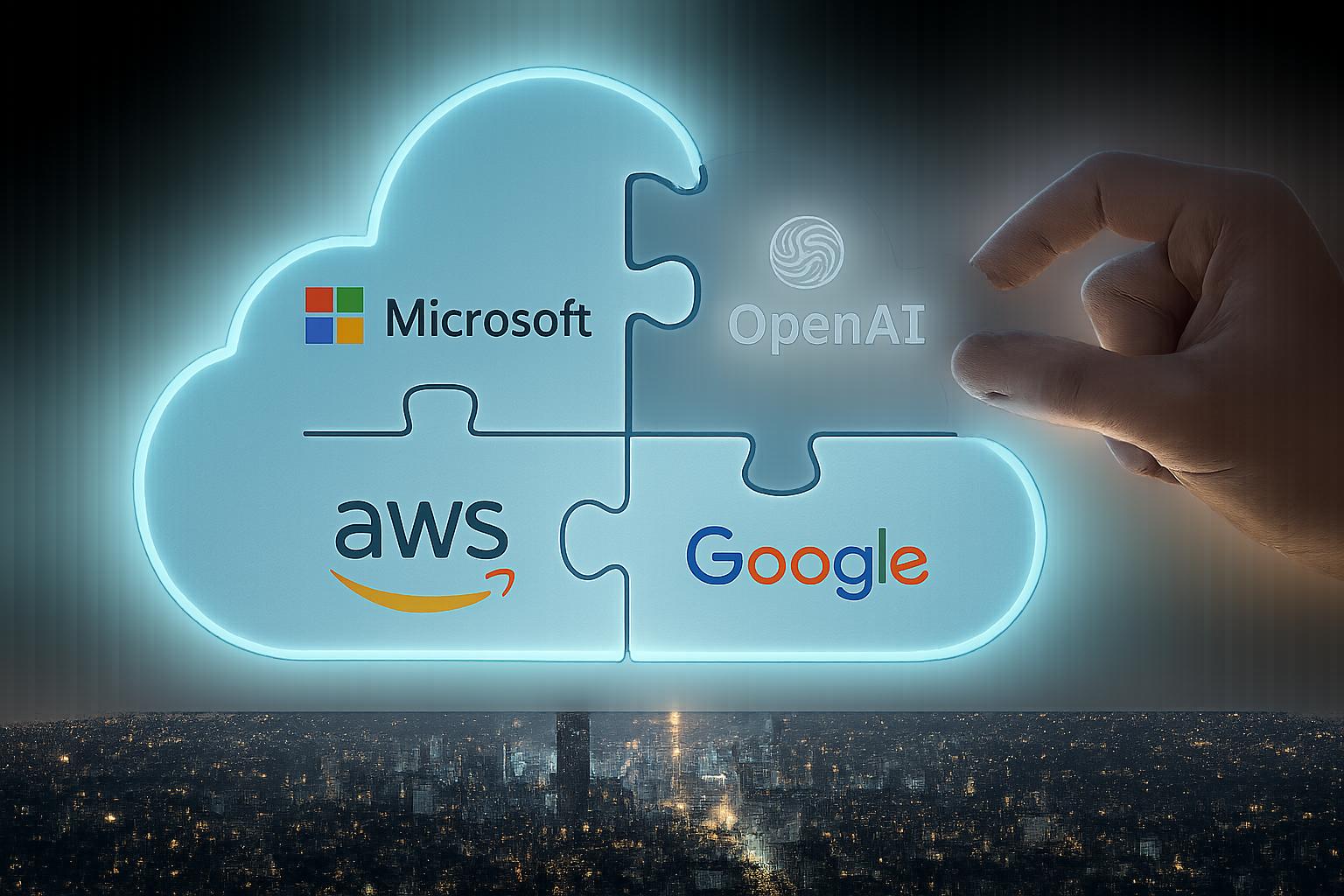
AI CERTS
4 hours ago
OpenAI, Microsoft and cloud infrastructure dependency roadmap
sal Stargate program. These decisions intertwine Azure build-out synchronization with fresh capacity sources. Industry observers, meanwhile, debate whether the changes really loosen lock-in or merely repackage it. Ultimately, long-term implications will hinge on power, chips, and regulation.
Partnership Shift Dynamics Today
Microsoft retains crucial commercial perks even after exclusivity dissolved. Furthermore, OpenAI keeps sending API calls through Azure, preserving revenue sharing. In contrast, compute for model training can now source from multiple vendors. This arrangement balances diversification with strategic alignment formalization goals.
Additionally, Microsoft disclosed a “large Azure commitment,” confirming ongoing Azure build-out synchronization. Analysts argue that balance improves OpenAI’s competitive positioning during a global accelerator shortage. Nevertheless, customers still depend on Azure endpoints to reach OpenAI models. These nuances illustrate how cloud infrastructure dependency evolves rather than disappears. These factors underscore persistent bargaining power asymmetries. Consequently, regulators remain focused on underlying market power.

ROFR Versus Past Exclusivity
The new Right of First Refusal clause offers optionality. Previously, Microsoft blocked rival suppliers entirely. Now, OpenAI may solicit proposals elsewhere; however, Microsoft can match terms first. Therefore, procurement agility improves without fully erasing lock-in concerns. Moreover, regulators perceive ROFR as less restrictive yet still influential. Enterprises watching this shift hope it informs their long-term capacity planning. Meanwhile, legal experts debate enforceability scopes across jurisdictions. Subtleties within the contract, including IP rights, will shape future strategic alignment formalization. Ultimately, ROFR introduces competitive pressure on pricing and delivery schedules. Yet, effective cloud infrastructure dependency persists through API exclusivity. These contract mechanics warrant close monitoring as new capacity deals emerge.
Stargate Expansion Scale Plans
OpenAI’s Stargate aims for ten gigawatts of AI power. Additionally, partners pledged an initial one hundred billion dollars. Oracle later added 4.5-gigawatt sites, accelerating momentum. Consequently, long-term capacity planning now involves multi-state real estate, power grids, and supply chains. The project directly intersects with Azure build-out synchronization because training datasets frequently land back on Microsoft infrastructure for inference. Moreover, SoftBank’s financing diversifies capital exposure, supporting better competitive positioning. Nevertheless, execution risks remain significant.
- $500 B total target across phases
- 10 GW aggregate power requirement
- 4.5 GW committed with Oracle in 2025
- Top three clouds hold 65% market share
These numbers dwarf typical hyperscale builds. Consequently, planners cite energy constraints as the defining variable. This scale summary clarifies why cloud infrastructure dependency must be distributed wisely. The magnitude also intensifies regulator interest ahead of capacity allocation debates.
Multi-Vendor Operational Complexity
Spreading workloads sounds simple yet proves arduous. Data gravity hampers cross-cloud migrations. Additionally, unified identity, networking, and observability stacks require re-engineering. Therefore, organizations must update long-term capacity planning frameworks. OpenAI tackles this by deploying orchestration layers that abstract accelerator pools. Meanwhile, cost models vary between reserved cloud instances and owned Stargate racks. Furthermore, strategic alignment formalization demands governance standards across partners.
Engineers state that effective Azure build-out synchronization remains vital for model evaluation pipelines. Ultimately, operational friction can blunt intended competitive positioning gains. Nevertheless, incremental automation progress reduces those barriers over time. These complexities illustrate how cloud infrastructure dependency influences architectural choices. Therefore, skills in multi-cloud DevOps will stay valuable.
Regulatory Scrutiny Intensifies Globally
Regulators increasingly analyze market concentration. The UK CMA highlighted unilateral power by Microsoft and Amazon. Moreover, egress fees and preferential licensing drive switching costs. Consequently, debates about cloud infrastructure dependency move from boardrooms to parliaments. In contrast, Microsoft argues that ROFR fosters competition. Meanwhile, enterprises lobby for interoperability mandates. The CMA’s provisional findings mention differential Azure pricing, complicating competitive positioning. Furthermore, EU digital rules may require contract transparency, impacting strategic alignment formalization. Analysts predict more filings as Stargate scales affect grid planning. These regulatory threads reinforce the urgency of thoughtful long-term capacity planning. Ultimately, legal outcomes could reshape hyperscaler economics.
Business Impact Forecast Trends
Corporate buyers track the partnership’s ripple effects. Consequently, procurement teams reassess discounts tied to single-vendor commitments. Moreover, secondary clouds tout flexibility messaging aligned with competitive positioning strategies. Financial analysts expect Microsoft to maintain margins through exclusive API routing. However, increased supply should temper GPU prices over time. Therefore, budget models integrate both leased and owned capacity scenarios. Additionally, investors gauge how Azure build-out synchronization dovetails with Stargate deployments. Strategic finance leaders embed long-term capacity planning into multi-year roadmaps. Ultimately, innovations stemming from cloud infrastructure dependency negotiations will influence enterprise total cost of ownership. These projections suggest a maturing, yet still volatile, AI infrastructure market.
Leadership Skills And Certifications
Executives steering these transitions need validated competence. Moreover, governance frameworks demand knowledge of compliance, security, and ROI trade-offs. Professionals can enhance their expertise with the AI Cloud Strategist™ certification. Consequently, teams gain shared language for strategic alignment formalization. Furthermore, coursework covers Azure build-out synchronization, vendor negotiations, and long-term capacity planning. These skills bolster competitive positioning during contract renewals. Ultimately, certification holders help organizations navigate persistent cloud infrastructure dependency. These education pathways align talent with emerging infrastructure realities.
The section emphasizes capability development. Meanwhile, it connects practical tooling with governance objectives.
Key Competency Highlights
• Evaluate ROFR clauses across providers.
• Model hybrid cost structures accurately.
• Map compliance risks within multi-cloud nodes.
These competencies translate strategic goals into technical actions. Consequently, companies close execution gaps.
Understanding leadership skill needs bridges infrastructure ambitions with operational success. Therefore, certification uptake is expected to rise.
Conclusion And Outlook
OpenAI’s recalibrated roadmap signals a nuanced era. Furthermore, Microsoft keeps commercial primacy while capacity diversification accelerates. Consequently, regulators probe the residual lock-in mechanics. Industry players refine long-term capacity planning amid shifting supply curves. Nevertheless, Stargate’s magnitude will redefine power and silicon markets. Ultimately, organizations should monitor evolving cloud infrastructure dependency patterns and adjust procurement playbooks. Professionals should also pursue structured learning to mitigate risk. Therefore, consider the linked certification to stay ahead of change.
Stay informed, skill up, and position your enterprise for resilient AI growth.



